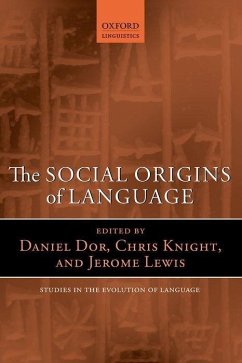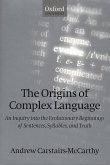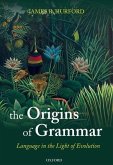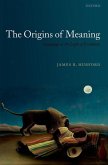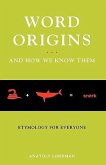Social Origins of Language
Herausgeber: Dor, Daniel; Lewis, Jerome; Knight, Chris
Social Origins of Language
Herausgeber: Dor, Daniel; Lewis, Jerome; Knight, Chris
- Gebundenes Buch
- Merkliste
- Auf die Merkliste
- Bewerten Bewerten
- Teilen
- Produkt teilen
- Produkterinnerung
- Produkterinnerung
This book presents a new perspective on the origins of language, and highlights the key role of social and cultural dynamics in driving language evolution. It considers, among other questions, the role of gesture in communication, mimesis, play, dance, and song in extant hunter-gatherer communities, and the time-frame for language evolution.
Andere Kunden interessierten sich auch für
![The Origins of Complex Language The Origins of Complex Language]() Andrew Carstairs-MccarthyThe Origins of Complex Language91,99 €
Andrew Carstairs-MccarthyThe Origins of Complex Language91,99 €![Language Origins Language Origins]() Maggie Tallerman (ed.)Language Origins263,99 €
Maggie Tallerman (ed.)Language Origins263,99 €![Origins of Sound Change Origins of Sound Change]() Origins of Sound Change170,99 €
Origins of Sound Change170,99 €![The Origins of Grammar The Origins of Grammar]() James R HurfordThe Origins of Grammar82,99 €
James R HurfordThe Origins of Grammar82,99 €![The Origins of Modern Literary Yiddish The Origins of Modern Literary Yiddish]() Dov-Ber KerlerThe Origins of Modern Literary Yiddish115,99 €
Dov-Ber KerlerThe Origins of Modern Literary Yiddish115,99 €![The Origins of Meaning The Origins of Meaning]() James R. HurfordThe Origins of Meaning87,99 €
James R. HurfordThe Origins of Meaning87,99 €![Word Origins ... and How We Know Them Word Origins ... and How We Know Them]() Anatoly LibermanWord Origins ... and How We Know Them38,99 €
Anatoly LibermanWord Origins ... and How We Know Them38,99 €-
-
-
This book presents a new perspective on the origins of language, and highlights the key role of social and cultural dynamics in driving language evolution. It considers, among other questions, the role of gesture in communication, mimesis, play, dance, and song in extant hunter-gatherer communities, and the time-frame for language evolution.
Produktdetails
- Produktdetails
- Verlag: Oxford University Press (UK)
- Seitenzahl: 454
- Erscheinungstermin: 19. August 2014
- Englisch
- Abmessung: 236mm x 163mm x 33mm
- Gewicht: 839g
- ISBN-13: 9780199665327
- ISBN-10: 019966532X
- Artikelnr.: 42384590
- Herstellerkennzeichnung
- Libri GmbH
- Europaallee 1
- 36244 Bad Hersfeld
- gpsr@libri.de
- Verlag: Oxford University Press (UK)
- Seitenzahl: 454
- Erscheinungstermin: 19. August 2014
- Englisch
- Abmessung: 236mm x 163mm x 33mm
- Gewicht: 839g
- ISBN-13: 9780199665327
- ISBN-10: 019966532X
- Artikelnr.: 42384590
- Herstellerkennzeichnung
- Libri GmbH
- Europaallee 1
- 36244 Bad Hersfeld
- gpsr@libri.de
Daniel Dor has a PhD in Linguistics from Stanford University, and is Senior Lecturer in Communication at Tel Aviv University. His main interest lies in the development of a theory of language as a communication technology. Together with Eva Jablonka, he has written extensively on the evolution of language. In a different (but related) domain, Dor has published books and articles on the role of the media, and its language, in the construction of political hegemony. His Intifada Hits the Headlines was chosen as book of the year 2004 in communication by Choice Magazine. Chris Knight was for many years Professor of Anthropology at the University of East London, although he is now retired. Best known for his 1991 book, Blood Relations: Menstruation and the Origins of Culture, he co-founded the Evolution of Language (EVOLANG) series of international conferences and has published widely on the evolutionary emergence of language and symbolic culture. Jerome Lewis lectures in Social Anthropology at University College London and co-directs the Hunter-Gatherer Resilience Project, the Extreme Citizen Science Research Group and UCL's Environment Institute. His research focuses on Pygmy hunter-gatherers and former hunter-gatherers in Central Africa. Current research focuses on communication and cultural transmission in egalitarian hunter-gatherer societies.
* 1: Daniel Dor, Chris Knight, and Jerome Lewis: Introduction: A social
perspective on how language began
* PART 1 Theoretical Foundations
* 2: Daniel Dor and Eva Jablonka: Why we need to move from gene-culture
co-evolution to culturally-driven co-evolution
* 3: Chris Sinha: Niche construction and semiosis: Biocultural and
social dynamics
* 4: Camilla Power: Signal evolution and the social brain
* 5: Sverker Johansson: How can a social theory of language evolution
be grounded in evidence?
* PART 2 Language as a Collective Object
* 6: Adam Kendon: The 'poly-modalic' nature of utterances and its
relevance for inquiring into language origins
* 7: Jerome Lewis: BaYaka Pygmy multi-modal and mimetic communication
traditions
* 8: Nick J. Enfield and Jack Sidnell: Language presupposes an
enchronic infrastructure for social interaction
* 9: Daniel Dor: The instruction of imagination: Language and its
evolution as a communication technology
* PART 3 Apes and People, Past and Present
* 10: Simone Pika: Chimpanzee grooming gestures and sounds: What might
they tell us about how language evolved?
* 11: Zanna Clay and Klaus Zuberbühler: Vocal communication and social
awareness in chimpanzees and bonobos
* 12: Charles Whitehead: Why humans and not apes: The social
preconditions for the emergence of language
* 13: Emily Wyman: Language and collective fiction: From children's
pretence to social institutions
* 14: Dan Dediu and Stephen C. Levinson: The time frame of the
emergence of modern language and its implications
* 15: Camilla Power: The evolution of ritual as a process of sexual
selection
* 16: Ian Watts: The red thread: Pigment use and the evolution of
collective ritual
* 17: Chris Knight: Language and symbolic culture: An outcome of
hunter-gatherer reverse dominance
* PART 4 The Social Origins of Language
* 18: Jordan Zlatev: The co-evolution of human intersubjectivity,
morality, and language
* 19: Ehud Lamm: Forever united: The co-evolution of language and
normativity
* 20: Jean-Louis Dessalles: Why talk?
* 21: Chris Knight and Jerome Lewis: Vocal deception, laughter, and the
linguistic significance of reverse dominance
* PART 5 The Journey Thereafter
* 22: Simona Ginsburg and Eva Jablonka: Memory, imagination, and the
evolution of modern language
* 23: Nick J. Enfield: Transmission biases in the cultural evolution of
language: Towards an explanatory framework
* 24: Luc Steels: Breaking down false barriers to understanding
perspective on how language began
* PART 1 Theoretical Foundations
* 2: Daniel Dor and Eva Jablonka: Why we need to move from gene-culture
co-evolution to culturally-driven co-evolution
* 3: Chris Sinha: Niche construction and semiosis: Biocultural and
social dynamics
* 4: Camilla Power: Signal evolution and the social brain
* 5: Sverker Johansson: How can a social theory of language evolution
be grounded in evidence?
* PART 2 Language as a Collective Object
* 6: Adam Kendon: The 'poly-modalic' nature of utterances and its
relevance for inquiring into language origins
* 7: Jerome Lewis: BaYaka Pygmy multi-modal and mimetic communication
traditions
* 8: Nick J. Enfield and Jack Sidnell: Language presupposes an
enchronic infrastructure for social interaction
* 9: Daniel Dor: The instruction of imagination: Language and its
evolution as a communication technology
* PART 3 Apes and People, Past and Present
* 10: Simone Pika: Chimpanzee grooming gestures and sounds: What might
they tell us about how language evolved?
* 11: Zanna Clay and Klaus Zuberbühler: Vocal communication and social
awareness in chimpanzees and bonobos
* 12: Charles Whitehead: Why humans and not apes: The social
preconditions for the emergence of language
* 13: Emily Wyman: Language and collective fiction: From children's
pretence to social institutions
* 14: Dan Dediu and Stephen C. Levinson: The time frame of the
emergence of modern language and its implications
* 15: Camilla Power: The evolution of ritual as a process of sexual
selection
* 16: Ian Watts: The red thread: Pigment use and the evolution of
collective ritual
* 17: Chris Knight: Language and symbolic culture: An outcome of
hunter-gatherer reverse dominance
* PART 4 The Social Origins of Language
* 18: Jordan Zlatev: The co-evolution of human intersubjectivity,
morality, and language
* 19: Ehud Lamm: Forever united: The co-evolution of language and
normativity
* 20: Jean-Louis Dessalles: Why talk?
* 21: Chris Knight and Jerome Lewis: Vocal deception, laughter, and the
linguistic significance of reverse dominance
* PART 5 The Journey Thereafter
* 22: Simona Ginsburg and Eva Jablonka: Memory, imagination, and the
evolution of modern language
* 23: Nick J. Enfield: Transmission biases in the cultural evolution of
language: Towards an explanatory framework
* 24: Luc Steels: Breaking down false barriers to understanding
* 1: Daniel Dor, Chris Knight, and Jerome Lewis: Introduction: A social
perspective on how language began
* PART 1 Theoretical Foundations
* 2: Daniel Dor and Eva Jablonka: Why we need to move from gene-culture
co-evolution to culturally-driven co-evolution
* 3: Chris Sinha: Niche construction and semiosis: Biocultural and
social dynamics
* 4: Camilla Power: Signal evolution and the social brain
* 5: Sverker Johansson: How can a social theory of language evolution
be grounded in evidence?
* PART 2 Language as a Collective Object
* 6: Adam Kendon: The 'poly-modalic' nature of utterances and its
relevance for inquiring into language origins
* 7: Jerome Lewis: BaYaka Pygmy multi-modal and mimetic communication
traditions
* 8: Nick J. Enfield and Jack Sidnell: Language presupposes an
enchronic infrastructure for social interaction
* 9: Daniel Dor: The instruction of imagination: Language and its
evolution as a communication technology
* PART 3 Apes and People, Past and Present
* 10: Simone Pika: Chimpanzee grooming gestures and sounds: What might
they tell us about how language evolved?
* 11: Zanna Clay and Klaus Zuberbühler: Vocal communication and social
awareness in chimpanzees and bonobos
* 12: Charles Whitehead: Why humans and not apes: The social
preconditions for the emergence of language
* 13: Emily Wyman: Language and collective fiction: From children's
pretence to social institutions
* 14: Dan Dediu and Stephen C. Levinson: The time frame of the
emergence of modern language and its implications
* 15: Camilla Power: The evolution of ritual as a process of sexual
selection
* 16: Ian Watts: The red thread: Pigment use and the evolution of
collective ritual
* 17: Chris Knight: Language and symbolic culture: An outcome of
hunter-gatherer reverse dominance
* PART 4 The Social Origins of Language
* 18: Jordan Zlatev: The co-evolution of human intersubjectivity,
morality, and language
* 19: Ehud Lamm: Forever united: The co-evolution of language and
normativity
* 20: Jean-Louis Dessalles: Why talk?
* 21: Chris Knight and Jerome Lewis: Vocal deception, laughter, and the
linguistic significance of reverse dominance
* PART 5 The Journey Thereafter
* 22: Simona Ginsburg and Eva Jablonka: Memory, imagination, and the
evolution of modern language
* 23: Nick J. Enfield: Transmission biases in the cultural evolution of
language: Towards an explanatory framework
* 24: Luc Steels: Breaking down false barriers to understanding
perspective on how language began
* PART 1 Theoretical Foundations
* 2: Daniel Dor and Eva Jablonka: Why we need to move from gene-culture
co-evolution to culturally-driven co-evolution
* 3: Chris Sinha: Niche construction and semiosis: Biocultural and
social dynamics
* 4: Camilla Power: Signal evolution and the social brain
* 5: Sverker Johansson: How can a social theory of language evolution
be grounded in evidence?
* PART 2 Language as a Collective Object
* 6: Adam Kendon: The 'poly-modalic' nature of utterances and its
relevance for inquiring into language origins
* 7: Jerome Lewis: BaYaka Pygmy multi-modal and mimetic communication
traditions
* 8: Nick J. Enfield and Jack Sidnell: Language presupposes an
enchronic infrastructure for social interaction
* 9: Daniel Dor: The instruction of imagination: Language and its
evolution as a communication technology
* PART 3 Apes and People, Past and Present
* 10: Simone Pika: Chimpanzee grooming gestures and sounds: What might
they tell us about how language evolved?
* 11: Zanna Clay and Klaus Zuberbühler: Vocal communication and social
awareness in chimpanzees and bonobos
* 12: Charles Whitehead: Why humans and not apes: The social
preconditions for the emergence of language
* 13: Emily Wyman: Language and collective fiction: From children's
pretence to social institutions
* 14: Dan Dediu and Stephen C. Levinson: The time frame of the
emergence of modern language and its implications
* 15: Camilla Power: The evolution of ritual as a process of sexual
selection
* 16: Ian Watts: The red thread: Pigment use and the evolution of
collective ritual
* 17: Chris Knight: Language and symbolic culture: An outcome of
hunter-gatherer reverse dominance
* PART 4 The Social Origins of Language
* 18: Jordan Zlatev: The co-evolution of human intersubjectivity,
morality, and language
* 19: Ehud Lamm: Forever united: The co-evolution of language and
normativity
* 20: Jean-Louis Dessalles: Why talk?
* 21: Chris Knight and Jerome Lewis: Vocal deception, laughter, and the
linguistic significance of reverse dominance
* PART 5 The Journey Thereafter
* 22: Simona Ginsburg and Eva Jablonka: Memory, imagination, and the
evolution of modern language
* 23: Nick J. Enfield: Transmission biases in the cultural evolution of
language: Towards an explanatory framework
* 24: Luc Steels: Breaking down false barriers to understanding

